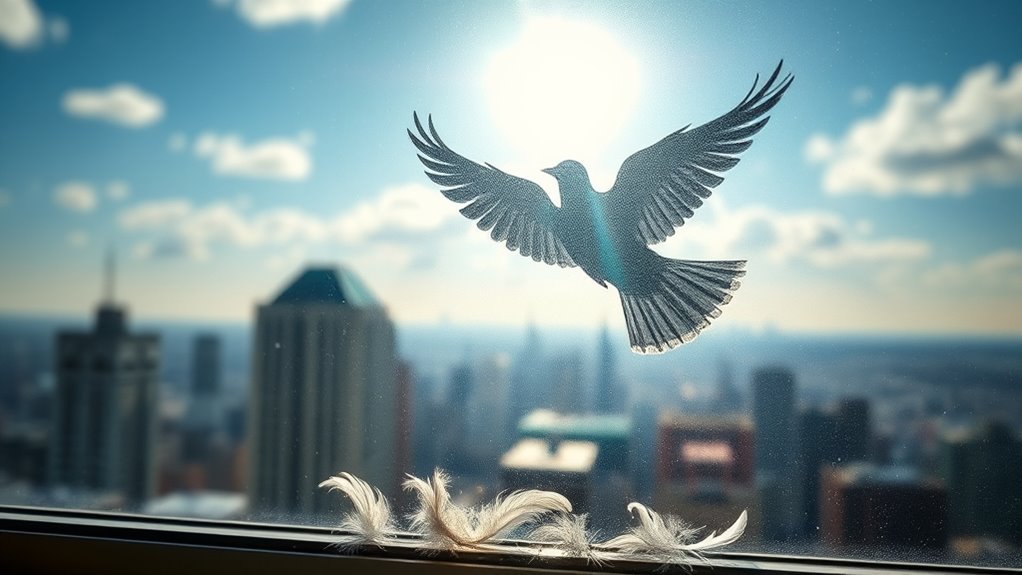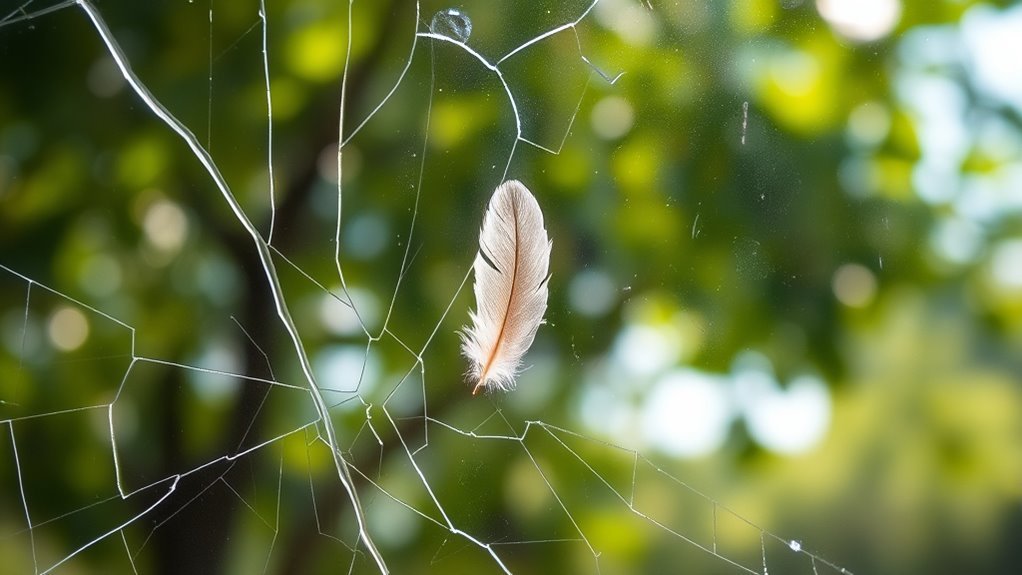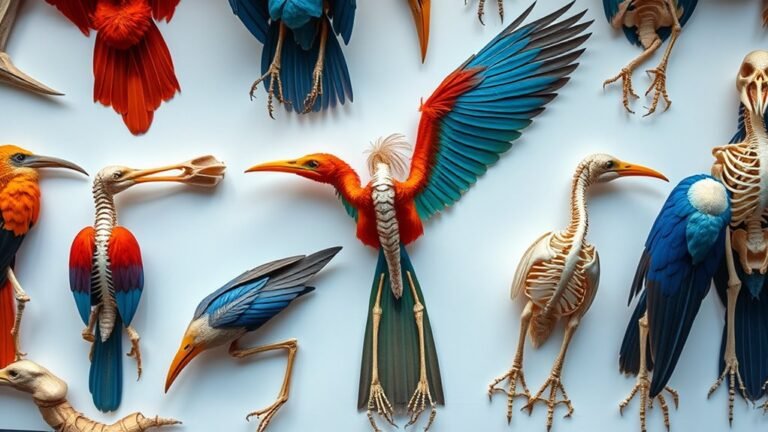Understanding the Impact of Birds Flying Into Windows
Every year, millions of birds fly into windows. This causes high death rates for many species, especially songbirds. Urban areas and shiny surfaces confuse these birds during migration. We need to look at the main reasons for these collisions and find ways to reduce them. Protecting bird populations is essential. What steps can we take to solve this issue?
Key Takeaways
- Millions of birds die annually from window collisions in urban environments, highlighting the severity of the issue.
- Reflective surfaces and smooth glass mislead birds into thinking they can fly through open space.
- Vulnerable species, particularly songbirds like sparrows and warblers, experience higher collision rates during migration.
- Innovative designs, such as window decals and etched glass, can significantly reduce bird strikes.
- Community initiatives and grassroots efforts play a crucial role in promoting bird-safe building designs and awareness.
The Scale of the Problem: Bird Collisions With Windows

Every year, millions of birds hit windows in the United States, creating a serious problem for bird populations. This high number shows that birds are changing their behavior as they adapt to cities with more buildings.
Tall buildings and large glass surfaces confuse birds during migration, leading to deadly crashes. Some species, like sparrows and warblers, are more likely to be affected, indicating a concerning trend in urban areas.
To help these birds, you can get involved in local projects that improve window safety. Solutions include adding bird-friendly films or screens to windows.
The Science Behind Window Strikes
Birds often collide with windows due to their behavior and the design of buildings. They mistake reflections on glass for open space or don't see the window as a barrier.
Birds that depend on visual landmarks for navigation are particularly affected. The design of windows matters; smooth, reflective surfaces or large panes increase the chance of strikes.
Research indicates that adding visual markers, like patterns or tints, can reduce these collisions.
Species at Risk: Who Is Most Affected?

Many birds are at risk of window strikes, but some species are more vulnerable due to their habits and habitats.
For example, songbirds like the American Robin and the Indigo Bunting frequently collide with windows, especially during migration. As they migrate, they often fly through urban areas with tall buildings, increasing their collisions with glass.
These birds typically don't see glass as a barrier, leading to unfortunate outcomes. Birds that live in open fields and urban spaces also face a higher risk due to reflective surfaces.
Factors Contributing to Bird Collisions
Several factors lead to bird collisions with windows.
Urban areas are a major cause, as closely packed buildings can confuse birds. Reflective surfaces make the problem worse; they can look like open skies or trees, misleading birds into flying toward them.
Some bird species are more prone to collisions, especially during migration when they're active and looking for food. Weather and lighting also increase the risk.
Understanding these issues encourages communities to take action and create designs that protect birds.
Innovative Solutions to Prevent Window Strikes

Bird collisions with windows are a serious problem. To solve this issue, researchers are creating new window designs. These designs use visual markers, like patterns or films, to help birds see and avoid barriers. Options include etched glass and decals that interfere with transparency and alert birds to danger.
Additionally, reflective surfaces are used to make flight paths less attractive for birds. These solutions reduce collisions while also improving the look of buildings. Homeowners and architects can work together to implement these designs, promoting wildlife protection in their communities.
Community Initiatives and Advocacy Efforts
Communities are recognizing the problem of bird collisions with windows and are taking steps to help. Local organizations are educating residents about how these collisions affect bird populations.
They hold workshops and launch informational campaigns to raise awareness and encourage responsibility.
Advocacy efforts include forming partnerships with local businesses to promote bird-friendly window solutions, like decals and films. Some communities have created "Bird-Safe City" programs to support building designs that protect birds.
How Individuals Can Make a Difference
Community efforts are vital for protecting birds, but individual actions can greatly enhance these efforts.
Simple changes, like using bird-safe glass or adding decals to windows, can significantly reduce collisions. Research indicates these modifications can lower bird injuries by over 50%.
Raising awareness is also important. Share what you know with friends and family to inspire others to support bird conservation.
You can organize neighborhood meetings or social media campaigns to encourage action. Every small effort adds up, creating a shared commitment to bird safety.
By educating yourself and advocating for birds, you can make a real impact.
Together, we can build a community dedicated to preserving our feathered friends.
Frequently Asked Questions
How Can I Identify if My Window Poses a Risk to Birds?
To determine if your window is a threat to birds, check its reflections. If birds frequently collide with it, they likely see it as open space. You can improve its visibility to reduce this risk. Consider adding decals or screens to help birds recognize the barrier.
Are Certain Times of Year More Dangerous for Bird Collisions?
Certain times of year, such as spring and fall, increase bird activity due to migration. Mating season also contributes to this rise in movement. During these periods, it is important to check window safety to help prevent bird collisions.
Do All Types of Birds Collide With Windows Equally?
Birds do not collide with windows equally. Their flight patterns and habitats significantly affect collision rates. Some bird species face higher risks due to their behavior, while others find ways to avoid crashes, reducing their chances of hitting windows. Understanding which birds are more vulnerable can help us create safer environments for them.
What Is the Average Number of Collisions per Year in Urban Areas?
In urban areas, millions of birds collide with windows every year. This statistic shows the impact of human development on bird populations. By understanding these numbers, you can participate in efforts to protect birds in your community. Simple actions, like using bird-friendly window treatments, can help reduce these collisions and support local wildlife. Together, we can make a difference for our feathered friends.
How Do Weather Conditions Affect Bird Window Strikes?
Weather conditions impact bird window strikes. Reduced visibility from rain or fog alters flight patterns and raises collision risks. This connection shows how weather affects these events significantly.

Hello, I’m Emily Price, the founder of Birds Affection. As a passionate bird enthusiast and spiritual seeker, I’ve always been fascinated by the symbolic meanings and mystical connections between birds and our lives. On this website, I share my knowledge and insights on the spiritual significance of various bird species, exploring their roles as messengers, guides, and teachers. Through my writing, I aim to inspire and educate others on the profound wisdom and beauty that birds bring to our world. Join me on this journey as we delve into the enchanting realm of bird symbolism and discover the hidden meanings behind these magnificent creatures.







